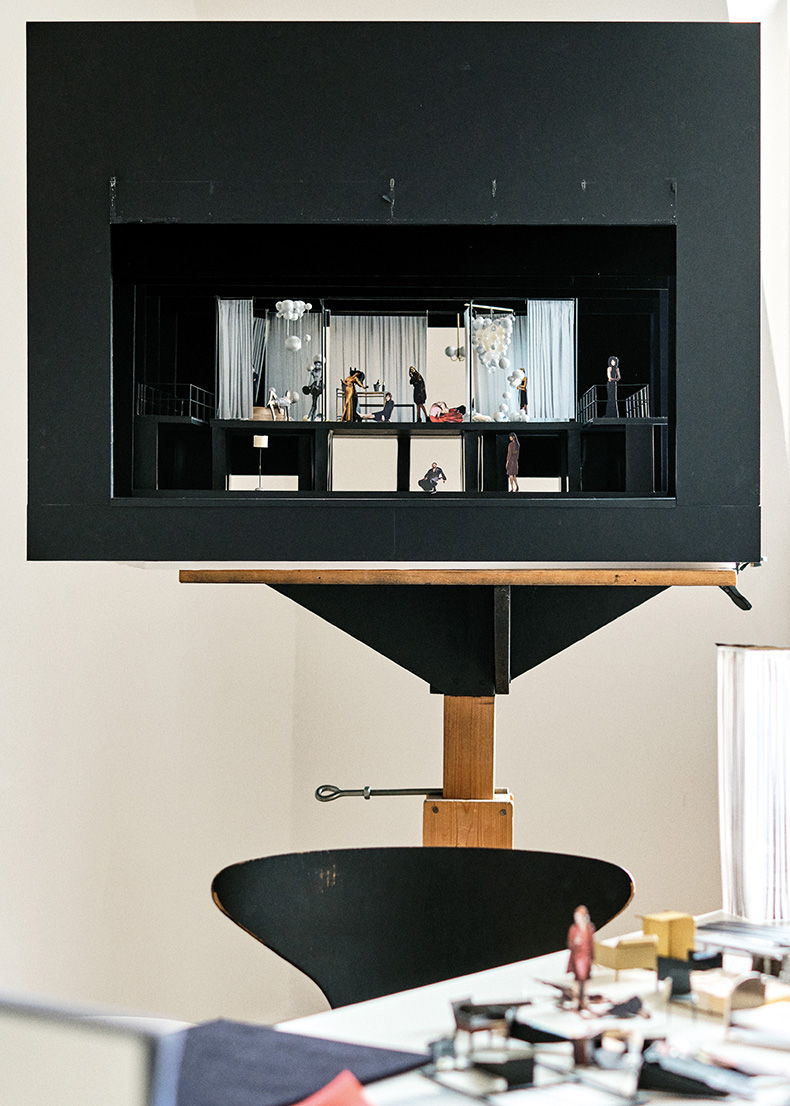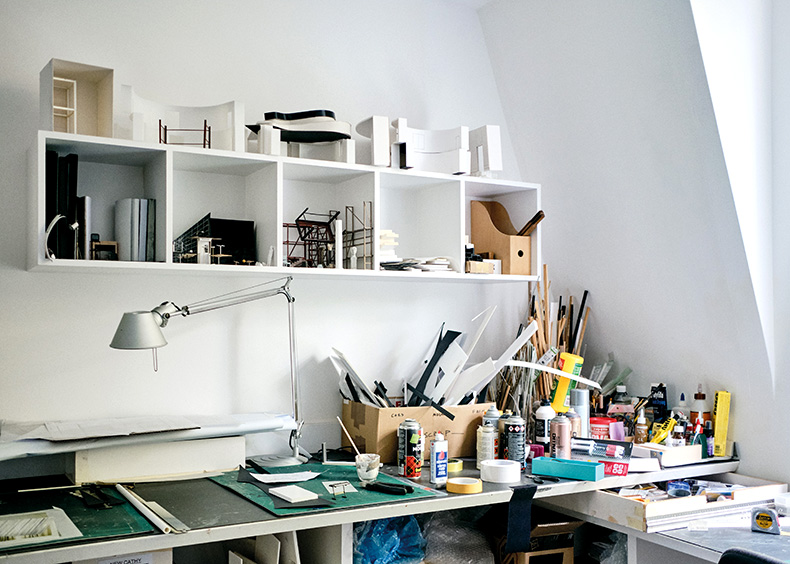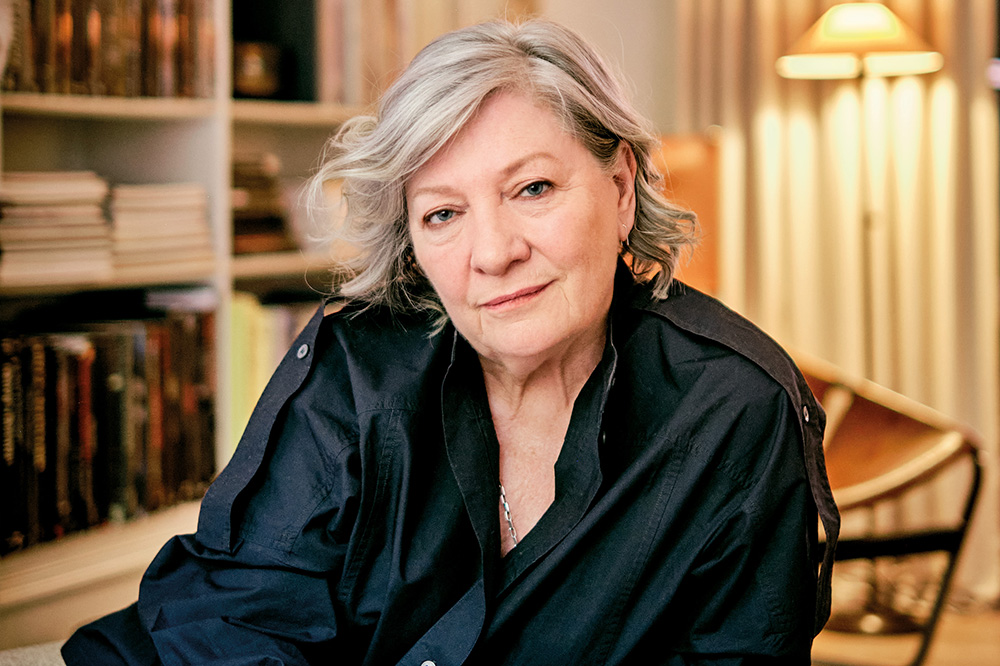What becomes clear, talking to Bechtler, is how important matching materials and images is to create the right feeling for a play. One of the productions she worked on that I remember best is Ian Rickson’s version of The Seagull at the Royal Court in 2007. The main thing people talked about was the extraordinary cast: Kristin Scott Thomas, Mackenzie Crook, Chiwetel Ejiofor and Carey Mulligan. The Court is a difficult stage: it is narrow and on one side there’s very little wing – you’re up hard against the architecture of the building. The challenge for Bechtler was to ‘make these rooms feel alive’. She asked the technical director if they could ‘buy a couple of trees and lay our own floor’. He agreed.
Kristin Scott Thomas and Chiwetel Ejiofor as Arkadina and Trigorin in The Seagull by Anton Chekhov, directed by Ian Rickson and designed by Hildegard Bechtler, at the Royal Court, London, in 2007. Photo: © Tristram Kenton
Bechtler wanted the floorboards to be wide, ‘because there’s something about lands, about Russian landscape, and there is something about nature.’ It was her way of bringing in ‘the usual trees’ but in a different way. The floorboards were so large they had to be turned each night so they didn’t bow. ‘People probably didn’t realise but the floor did things, it’s emotional.’ There is something poetic about taking a traditional symbol of Chekhovian Russia and making it fresh, reworking it to create not an image but a feeling.
Most of the design process seems to consist of conversation. Bechtler relies on meetings with directors in which they work together to solve the problem of the play. Part of it is practical but it goes beyond that. One reason she and Warner worked together for a decade is because Warner ‘was somebody who said the right things’. When they met to discuss Electra, Warner told Bechtler that she was thinking of the title character as somebody who rolls her own cigarettes; perhaps, she added, there was milk in vast metal containers on stage. ‘None of that happened,’ Bechtler says, ‘but it catapults you into a very different direction.’
Conversation is both the engine and where it starts. If a director wants to work with Bechtler they had better ensure that they have prepared properly. Trevor Nunn had one ‘wonderful, wonderful conversation’ with her about The Merchant of Venice at the National (1999), which was lucky as his obligations as the theatre’s artistic director meant that Bechtler didn’t get much more time with him. When they transferred the production from the small studio space then known as the Cottesloe to the theatre’s largest stage, certain things had to change. Bechtler wanted to introduce a wall to help with the staging. She asked the production team to build it and it was only on the evening of the technical rehearsal that she begged Nunn to think about using it. The next morning he agreed. (I suspect Bechtler usually gets her way, mainly because she is right.)
It was a conversation with her latest collaborator, Robert Icke, that started their working relationship too. As an associate at the Almeida, Icke was talking to designers about his production of the Oresteia (2015). ‘I immediately felt, yes, I want to do this. I’d never seen anything he’d done but both of us understood the way we were talking about the play. You could go in any direction and somehow it seemed to bring things up which started the next thing. It was what I call a good conversation,’ she says. The result was a boldly clinical set, all glass and hard surfaces for Icke to impose his vision of the play upon, the story translated into a terrifying criminal case to be judged.
Bechtler is currently working with Icke on a production of Don Giovanni for the opera festival at Aix-en-Provence. She has designed it before, at Glyndebourne for Warner, but this feels quite different. For opera there is another voice in the conversation, as the starting point has to be the music. ‘The music inspires,’ says Bechtler. And while you have to match the music in the design, ‘people are supported by the music’. Icke is ‘very interesting to listen to the music with’; it’s clear from how Bechtler describes the process that with opera, it’s the music that opens up the conversation.

A model box containing Bechtler’s set designs for Don Giovanni at the Aix-en-Provence opera festival. Photo: C.L. Proctor
Of course, you eventually have to bring the conversation round to something concrete. ‘I love imagery,’ Bechtler says. Referring to her design for Hamlet (2017), which she also did with Icke, she says, ‘I can show a director a woman, say, for a scene, cowering behind a sofa or in a bathtub with the head hanging out, a wonderful photo taken by somebody interesting, and there’s something in that emotionally that is so right that it might find its way into getting re-enacted. There might be an actress behind a sofa – in fact, that happened. And also we had a bath, just for a moment.’ It’s that magpie tendency of filing away images and influences and bringing them out to create emotion, to create a world that actors can inhabit, that is the stuff of Bechtler’s design.
As I think about our own conversation, I wonder why talking is an intrinsic part of the process. Not everyone can exchange ideas so freely and still produce tangible results. But then I remember what Bechtler said at the start of our interview about why she came to England. ‘I was born in 1951. This was the period when no one talked about what had just happened,’ she says. ‘I wanted questions answered. There was quite an anger among that generation. In school, in society, in the home, nobody discussed any of it.’ Things weren’t much better in England – ‘when I arrived in England it was this horrible baddies/goodies’ – but ‘it was for the deepest reason I left, I didn’t like it there.’ Bechtler might have devoted her life to creating the background for things that didn’t really happen but in all the conversation, the interrogation, the pinning down, perhaps what she is really getting to is the truth. Rather than building sets, she’s using conversation to bring into the light so much of what is left invisible.

Hildegard Bechtler’s workroom, part of her studio in north London. Photo: C.L. Proctor
From the July/August 2024 issue of Apollo. Preview and subscribe here.
